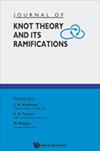Petal Number of Torus Knots Using Superbridge Indices
IF 0.3
4区 数学
Q4 MATHEMATICS
引用次数: 2
Abstract
A petal projection of a knot $K$ is a projection of a knot which consists of a single multi-crossing and non-nested loops. Since a petal projection gives a sequence of natural numbers for a given knot, the petal projection is a useful model to study knot theory. It is known that every knot has a petal projection. A petal number $p(K)$ is the minimum number of loops required to represent the knot $K$ as a petal projection. In this paper, we find the relation between a superbridge index and a petal number of an arbitrary knot. By using this relation, we find the petal number of $T_{r,s}$ as follows; $$p(T_{r,s})=2s-1$$ when $1利用超桥指数的环面结花瓣数
一个结的花瓣投影$K$是一个结的投影,它由一个单一的多交叉和非嵌套的循环组成。由于花瓣投影给出了给定结的自然数序列,因此花瓣投影是研究结理论的一个有用模型。众所周知,每个结都有一个花瓣突起。花瓣数$p(K)$是将结$K$表示为花瓣投影所需的最小循环数。本文研究了任意结点的超桥指数与花瓣数之间的关系。利用这个关系,我们得到$T_{r,s}$的花瓣数为:$$p(T_{r,s})=2s-1$$当$1
本文章由计算机程序翻译,如有差异,请以英文原文为准。
求助全文
约1分钟内获得全文
求助全文
来源期刊
CiteScore
0.80
自引率
40.00%
发文量
127
审稿时长
4-8 weeks
期刊介绍:
This Journal is intended as a forum for new developments in knot theory, particularly developments that create connections between knot theory and other aspects of mathematics and natural science. Our stance is interdisciplinary due to the nature of the subject. Knot theory as a core mathematical discipline is subject to many forms of generalization (virtual knots and links, higher-dimensional knots, knots and links in other manifolds, non-spherical knots, recursive systems analogous to knotting). Knots live in a wider mathematical framework (classification of three and higher dimensional manifolds, statistical mechanics and quantum theory, quantum groups, combinatorics of Gauss codes, combinatorics, algorithms and computational complexity, category theory and categorification of topological and algebraic structures, algebraic topology, topological quantum field theories).
Papers that will be published include:
-new research in the theory of knots and links, and their applications;
-new research in related fields;
-tutorial and review papers.
With this Journal, we hope to serve well researchers in knot theory and related areas of topology, researchers using knot theory in their work, and scientists interested in becoming informed about current work in the theory of knots and its ramifications.
联系我们:info@booksci.cn
Book学术提供免费学术资源搜索服务,方便国内外学者检索中英文文献。致力于提供最便捷和优质的服务体验。
Copyright © 2023 布克学术 All rights reserved.
京ICP备2023020795号-1
 京公网安备 11010802042870号
京公网安备 11010802042870号
京ICP备2023020795号-1

Book学术文献互助群
群 号:604180095


 求助内容:
求助内容: 应助结果提醒方式:
应助结果提醒方式:
